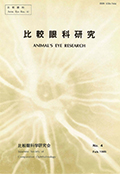Clinical cases of Akita dogs with lesions of the skin, mucosa, and eyes were reviewed. The occurrence was limited to Akita dogs and incidence of several cases in one blood family indicated some relation of a hereditary factor to the pathogenesis of this disorder. The age of the onset was mostly around one year, and there was no sexual bias.
The main clinical signs at onset were lacrimation and/or slight eye discharge. Diffuse to patchy fading of pigment and vitiligo on muzzle and lips were frequently noted following the cloudiness of the cornea. These signs regressed spontaneously at early stages, but there were repeated recurrences. Cloudiness of the cornea frequently developed more intensely and widely with or without conjunctivitis, and pannus was also distinct in some cases. Later, hyphemia, uveal staphyloma, adhesion of iris to cornea, cataract, and clouding of the corpus vitreum were observed, and then panophthalmitis and blindness leading to atrophia bulbi and enophthalmitis developed at the terminal stage. Depigmentation and pigmentation repeatedly occurred on the muzzle, lips, anus, vulva, and around eyes. Hyperkeratinization, bleeding, and crust formation were distinct on the muzzle in some cases. Stomatitis or oral ulcer was sometimes observed, and eczematous dermatosis with exudate and crusts occurred especially around the eyes and on the dorsal nasal surface. Errosive lesions were seen recurrently on the scrotum and around the vulva in some cases. Some patient dogs barked huskily and bent their heads to one direction.
Though examination of the ocular fundus could not be carried out in many cases because of the cloudiness of the cornea, it revealed yellowish gray or gray spots on the fundus in some cases. Chorioditis was confirmed by fluorescein angiography with extensive leakage of dye in the lesions.
Ordinary laboratory examination disclosed no specific changes in these cases. However, cellular and humoral immunity against canine malignant melanoma cells examined by microcytotoxicity assay and indirect immunofluorescent technique suggested that immunological reaction against melanocyte cells might be involved in the pathogenesis of this disorder.
From these findings, the cases were diagnosed as a mucocutaneous ocular syndrome of canine clinical entity due to unknown cause.
抄録全体を表示
